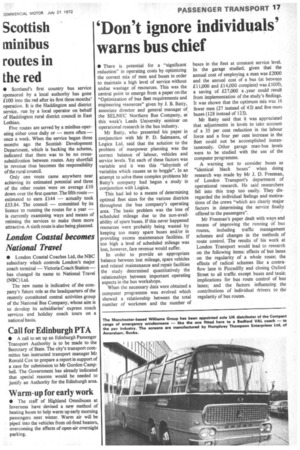'Don't ignore individuals' warns bus chief
Page 19

If you've noticed an error in this article please click here to report it so we can fix it.
• There is potential for a "significant reduction" in operating costs by optimizing the correct mix of men and buses in order to maintain a high level of service without undue wastage of resources. This was the central point to emerge from a paper on,the "Optimization of bus fleet requirements and engineering resources" given by J. B. Batty, associate director and general manager of the SELNEC Northern Bus Company, at this week's Leeds University seminar on operational research in the bus industry.
Mr Batty, who presented his paper in conjunction with Mr P. D. Salmaans, of Logica Ltd, said that the solution to the problem of manpower planning was the correct balance of labour, vehicles and service levels. Yet each of these factors was variable and it was this "labyrinth of variables which causes us to boggle". In an attempt to solve these complex problems Mr Batty's company had begun a study in conjunction with Logica.
This had led to a means of determining optimal fleet sizes for the various districts throughout the bus company's operating area. The basic problem was the loss of scheduled mileage due to the non-availability of spare buses. If this never happened resources were probably being wasted by keeping too many spare buses and/or in providing excess maintenance facilities. If too high a level of scheduled mileage was lost, however, fare revenue would suffer.
In order to provide an appropriate balance between lost mileage, spare vehicles and related maintenance and repair facilities the study determined quantitatively the relationships between important operating aspects in the bus workshops.
When the necessary data were obtained a computer programme was evolved which showed a relationship between the total number of workmen and the number of buses in the fleet at constant service level. In the garage studied, given that the annual cost of employing a man was £2000 and the annual cost of a bus (at between £11,000 and £14,000 complete) was £1000, a saving of £27,000 a year could result from implementation of the study's findings. It was shown that the optimum mix was 16 fewer men (27 instead of 43) and five more buses (128 instead of 123).
Mr Batty said that it was appreciated that adjustments in levels to take account of a 35 per cent reduction in the labour force and a four per cent increase in the fleet could not be accomplished instantaneously. Other garage man-bus levels were to be studied with the use of the computer programme.
A warning not to consider buses as "identical black boxes" when doing research was made by Mr J. D. Freeman, of London Transport's department of operational research. He said researchers fell into this trap too easily. They disregarded the individual feelings and motivations of the crews "which are clearly major factors in determining the service finally offered to the passengers".
Mr Freeman's paper dealt with ways and means of improving the running of bus routes, including traffic management schemes and changes in the methods of route control. The results of his work at London Transport would lead to research on the following items: effects of bus lanes on the regularity of a whole route; the effects of radical schemes like a contra flow lane in Piccadilly and closing Oxford Street to all traffic except buses and taxis; implications for bus route control of bus lanes; and the factors influencing the contributions of individual drivers to the regularity of bus routes.




























































































